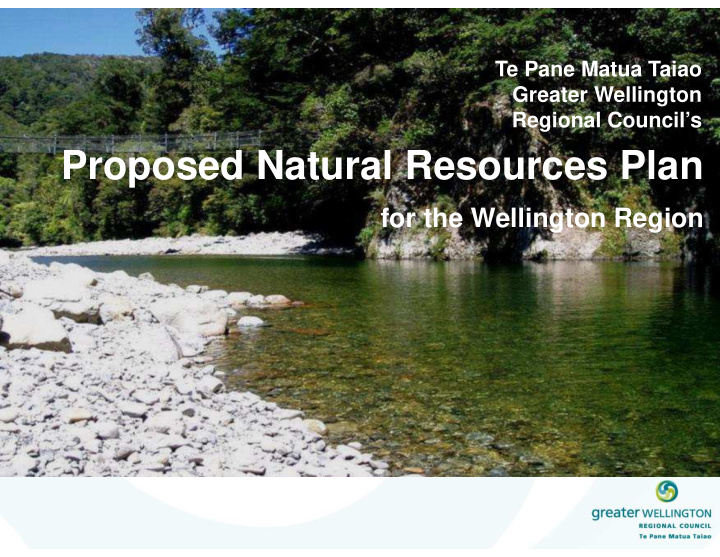



Te Pane Matua Taiao Greater Wellington Regional Council’s Proposed Natural Resources Plan for the Wellington Region
What is in the Plan that is relevant to your whaitua process ?
Goals in the Proposed Natural Resources Plan � Provide a framework for Integrated Land and Water Management (Whaitua) � Improve water quality and water use efficiency � Identify values and places for protection � Support economic wellbeing � Provide opportunities for partnerships with communities and TAs � A clear single plan and greater certainty to natural resources users
Whaitua committees are making RMA law � The whaitua committees are working to write parts of the regional plan which means � Giving effect to the Regional Policy Statement � Giving effect to the New Zealand Coastal Policy Statement, National Policy Statement for Freshwater Management � Implementing the RMA � Identifying programmes and investments that may shape investment under council plans, So you are doing the local bits in a regional context
Improving water quality over time
Process for developing whaitua chapters
Whaitua - Integrated Catchment Management
What’s the difference? ‘Water quality limits for freshwater set for the catchment in partnership with the community of the catchment’ � Catchment based water allocation and water quality management � Equal focus on both urban and rural uses � Changing the way we do things – combining rules and non regulatory actions � Working in defined catchment areas - whaitua process
Water Quality – the big picture � Maintain or improve water quality • Describe water quality that supports ecosystem health and mahinga kai, contact recreation and mana whenua use • Series of targeted non – statutory programmes to improve water quality in priority catchments � Water quality limits, targets and timeframes - focus of the whaitua process � Achieving secondary and primary contact recreation, over time � Approaches to improve water quality, over time
Water Quality – Objectives � Objective O5 � Freshwater bodies as a minimum are managed to safeguard ecosystem health and mahinga kai, provide for contact recreation and M ā ori customary use and health needs of people (freshwater) � Objective O23- water quality maintained or improved � Objective O24 � water contact recreation, secondary every where, primary contact in significant contact recreation water bodies � Objective O25 - aquatic ecosystem health and mahinga kai – maintain and improve over time where outcomes not met � Note whaitua sections take precedence
Water quality for recreation � Secondary contact - everywhere to meet national bottom-line • Of RSoE two sites will need improvement, over tim e – other methods • Priorities sites/river close to national bottom-line – whaitua � Primary contact – swimming in our rivers • Regional Policy Statement – significant rivers for swimming • Minimum for primary contact recreation – Match the national approach • Priorities – two Significant Rivers will need improvement, overtime � Coast - Primary contact standards outside of the Port Area – priorities for improvement identified.
Rural water quality � No specific nutrient limits or leaching loads • Limits through the whaitua process • Integrated catchment management solutions a major focus � Actions to maintain or improve water quality in rural area • Riparian setbacks for cultivation and break-feeding • Livestock excluded from most surface waters in intensively farmed areas – 2015-2022 • Control activities on steep slopes • Priority catchment programmes to advance good management practice, linked to areas with poorer water quality
Urban water quality Stormwater management � Two step process for community/council networks 1 st - Controlled activity (2+5 years) • • Identify networks – work with storm water managers • Prepare Stormwater Management Plans – link with Whaitua 2 nd – Longer-term consents and Stormwater • Management Plan • Set objectives and priorities – Whaitua • Integrate asset management and planning processes • Longer-term plans to improve water quality
Urban water quality Wastewater � Effects based approach to minimise adverse effects of wastewater – fresh and coastal � The quality of existing discharges progressively improved and the quantity reduced - no time � Existing discharges to fresh or coastal following rainfall progressively reduced - no timeframes � New discharges to freshwater are non-complying � New discharges to the coast are discretionary � Engagement with Iwi - reasonable steps to reflect interests and values – NPS-FM
Water allocation
Water allocation � Integrate surface and ground water resource management � No claw backs � Existing users retain their water � New users meet allocation limits � Transition period (4 years) to meet efficiency criteria � Minimum flows effectively unchanged – whaitua � whaitua also - � Review allocation limits � explore options for transfer and for maximising efficient allocation and use
Where to from here? � Notification 31 July 2015 : • 2 month submission period to end of September/October • Summary of submissions and further submissions through to January/February 2016 � Early-mid 2016 • Pre-hearing meetings • Officers s42A reports and circulation of evidence • Hearings late 2016- early 2017
Questions…
Internal Contact details Miranda Cross Environment Policy Team leader 04 830 4204 Miranda.cross@gw.govt.nz Lucy Harper Environment Policy Team leader 06 826 1529 lucy.harper@gw.govt.nz Jonathan Streat Environment Policy Manager 04 830 4320 jonathan.streat@gw.govt.nz
Recommend
More recommend